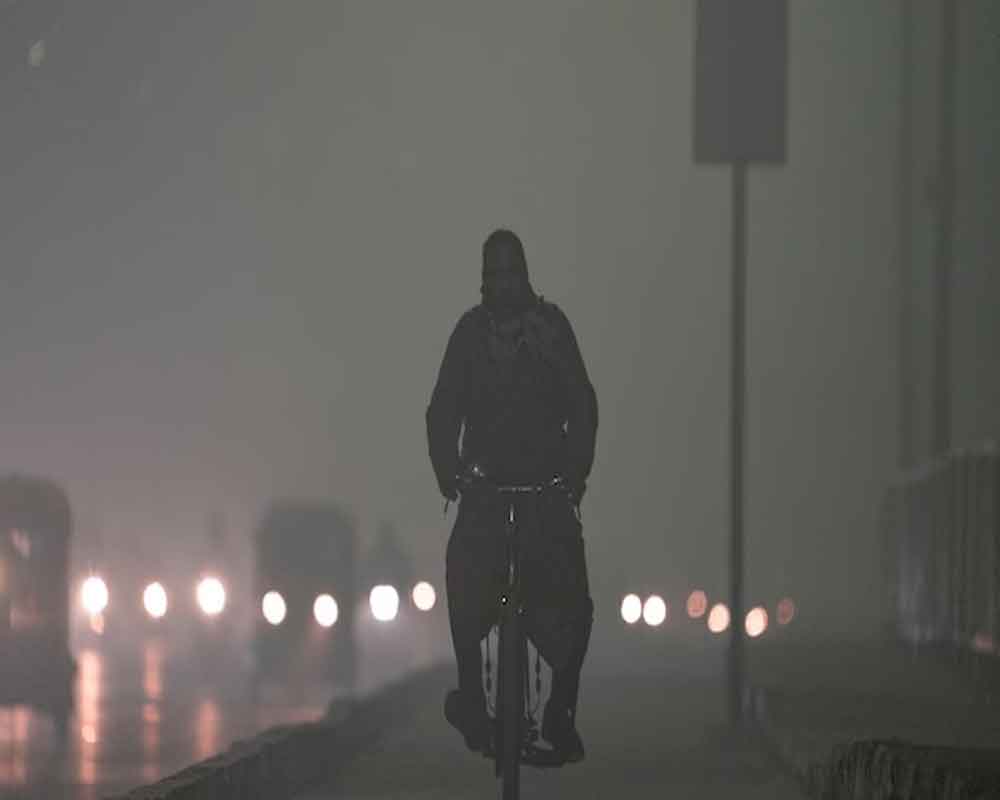Satellite images showed the season’s largest fog, stretching from Pakistan to Jharkhand and Jammu and Kashmir to Madhya Pradesh on Saturday morning, kept the sun away for all, leaving people shivering in what was the coldest daytime temperature recorded this winter. Delhi will continue to shiver as the mercury drops further over the eve of the New Year, with the maximum temperature settling at 20.3 degrees Celsius on Saturday, even though the nighttime temperature, or minimum, settled five notches above normal for this time of the year at 11.8°C.
According to the India Meteorological Department (IMD), a layer of moderate to dense fog is likely to blanket the city on Sunday as well. The sky will remain partly cloudy, and the maximum and minimum temperatures are expected to settle around 19 and 11 degrees Celsius, respectively. It said intense fog and slow movement of wind led to a deterioration in the air quality index (AQI) in the national capital, which touched the very poor category. The 24-hour average AQI of Delhi was at 400 at 4 pm, compared to 358 on Friday. AQI stood at 516 at Anand Vihar, 475 at ITI Shahdara, 461 at Sonia Vihar, 418 at Pusa, 398 at Major Dhyan Chand Stadium, 388 at the US Embassy, and 362 at Satyawati College. The IMD issued a red alert, saying that ‘very dense’ fog is likely to continue over many parts of the plains of Northwest and adjoining Central India and is likely to further extend to East India during the next two days. The IMD predicted the daytime chill to persist since a layer of fog in the higher altitudes that has been blocking the sun is not predicted to lift for another couple of days.
However, both these numbers were yet to meet thresholds for a cold wave or “cold day” temperatures. Low daytime temperatures can exacerbate people’s exposure to the cold and generally make the winter feel more intense since this is when people are usually outside the comfort of their homes.
A cold day is when the maximum temperature is 4.5°C or more below normal, and the minimum is below 10°C. While the maximum criteria were met at some stations, the minimum was not. But the shrinking difference between maximum and minimum signals the start of peak winter conditions, which takes place towards the end of December and lasts until mid-January.
As December comes to an end with temperatures higher than usual in Delhi, with no ‘cold wave’ days or ‘cold days’, the average maximum and minimum temperatures for December so far this year are higher than they were for the month in recent years. The average maximum temperature of 24.36 degrees Celsius is the highest for the city from 2017 onwards, while the average minimum temperature of 8.36 degrees Celsius is the highest from 2018 onwards.
Intense to moderate fog was witnessed in parts of Delhi, with the lowest visibility recorded at 200 meters at Safdarjung, the capital’s main weather station. Visibility at Palam and Ridge remained above 500 meters as compared to previous days. However, the intensity of the fog decreased a bit at several places in Delhi, and visibility improved from 500 m to 600 m. Multiple flights and trains have been delayed in the national capital as dense fog disrupted travel once again on Saturday.
More than 80 flights were delayed due to fog and low visibility in the national capital. The Indira Gandhi International Airport (IGIA) reported no flight cancellations or diversions on Saturday. The delays, attributed to poor visibility and foggy weather, affected the schedules of several passengers, leading to frustration and inconvenience. Not only air travel but ground transportation also experienced setbacks as some trains in Delhi faced delays due to fog and low visibility. Passengers heading to their destinations expressed their grievances as their travel plans were disrupted. Besides flights, some trains were also running late due to low visibility caused by dense fog. Northern Railway, meanwhile, said at least 30 trains to and from Delhi were running at a delay of more than one hour.
The National Highways Authority of India (NHAI) will create awareness among highway users to use blinkers and follow traffic rules during foggy conditions to reduce accidents. In addition, the NHAI statement said that NHAI field offices have been directed to undertake nighttime highway inspection on a weekly basis by a team consisting of NHAI officials, independent engineers, and concessionaire/contractor to assess visibility on the highway and identify locations for installing additional provisions as required. Also, highway patrol vehicles will be stationed near dense foggy stretches. According to the statement, the highway operation and maintenance team will carry a red/green blinking baton for guiding traffic in case of an accident and establish seamless collaboration with local law enforcement, ambulance services, and municipal authorities.


























